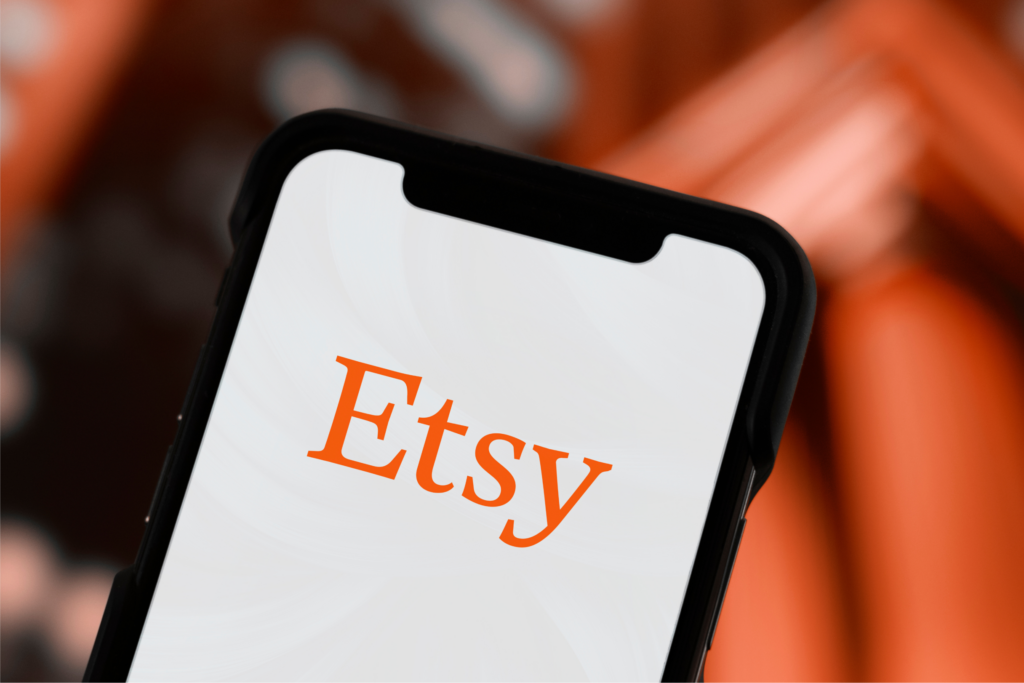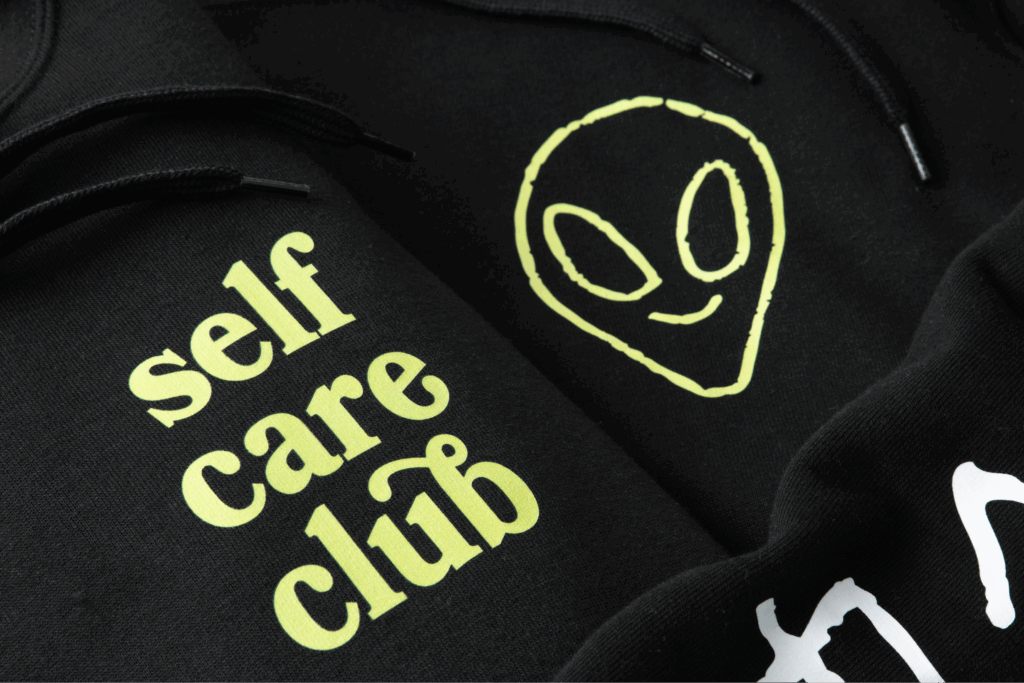Your business, your way – sell with Printify
Print on Demand vs dropshipping – which is the better business model? If you’re looking to start an online business, you’ve probably considered both options. While similar, each has pros and cons depending on your vision for your eCommerce store.
In this guide, we’ll compare Print on Demand and dropshipping, examining their difficulty levels, costs, and profit margins.
Key takeaways
- Dropshipping and Print on Demand are both profitable, low-risk, and beginner-friendly business models.
- Both options let anyone start an eCommerce business without dealing with inventory management, storage space, or shipping responsibilities.
- Print on Demand is an ideal business model for people who want to sell custom products, like t-shirts and mugs, with their own designs.
- The dropshipping model is a good option for those who want to start a business quickly without customizing their products.
What is Print on Demand?

Print on Demand (POD) lets you sell products with your own custom designs – like t-shirts, hoodies, mugs, and tote bags – without inventory management or upfront investment. You’ll work with a supplier who prints and ships each item only after a customer places an order.
Best for: Creators or entrepreneurs who want to build their own brand with zero upfront costs and no inventory.
How POD works:
- Sign up with a print-on-demand company like Printify.
- Choose products and upload your custom designs.
- Connect to your online store or marketplace and list your products.
- When a customer orders, the printing business produces, packs, and ships the item directly to them.
Read our guide on how to start a print-on-demand business for step-by-step instructions.
What is dropshipping?

Dropshipping is similar to Print on Demand – you don’t need to worry about production or shipping, and you don’t pay for the product until a customer orders it. However, you don’t have the option to customize your items.
That means you’re not limited to printable goods – you can dropship a wide range of items like gadgets, kitchen tools, home decor, phone accessories, and more.
Best for: Sellers who want to test product ideas fast or build a store around trending items without creating custom designs.
How dropshipping works:
- Choose one or several dropshipping suppliers and list products in your online store.
- A customer purchases a product from your dropshipping store at the retail price.
- Send the information to the dropshipping supplier and pay the wholesale price.
- The supplier ships products directly to the customer’s address from their nearest fulfillment center.
Learn how to start a dropshipping business from our blog.
Print on Demand vs dropshipping: A comprehensive overview
Here’s a quick overview of the Print on Demand and dropshipping business models.
| Print on Demand | Dropshipping | |
|---|---|---|
| Difficulty level | Easier for beginners – simple setup and no upfront costs. | Beginner-friendly but varies – some platforms require manual order processing or upfront payment. |
| Inventory management | Made to order – suppliers print products after there’s a purchase. | Already made and ready to ship, resulting in shorter fulfillment times. |
| Costs | Pay for printing and blank products only after each sale. | Pay wholesale prices for products – may include subscription fees to access the catalog. |
| Product customization | Customize products with your own designs. | No customization. |
| Product selection and quality | Printable items like t-shirts, mugs, and posters. Quality varies by supplier, but it’s possible to order samples. | A wider range of products, like tech gadgets and electronics. Quality varies by supplier. |
| Branding options | Offers options like branded packing, neck labels, and pack-ins. | Limited branding control unless working with private-label services. |
| Competition | Less competition because you sell products with custom designs. | High competition since other dropshipping sellers will likely offer the same products. |
| Minimum order requirements | No order minimums. | Some companies have order minimums or require a minimum monthly sales volume. |
| Shipping time | Varies by supplier location. Printify routes orders through the closest Provider when possible to reduce delivery times. | Shipping can be longer if suppliers are based overseas or in centralized locations. |
| Profit margins | Higher potential margins – 40% or more – if your designs are original and niche. | Lower average margins – around 15-20% – due to high competition and generic items. |
| Integrations | Easy integrations with eCommerce platforms and marketplaces. | Integrates with most platforms, but some specialty marketplaces like Etsy may restrict generic dropshipped items. |
Key differences between dropshipping and Print on Demand
Difficulty level
Print on Demand
POD is simpler for most beginners. The setup is fast, and since you only pay for products after a customer places an order, there are no upfront costs.
Choosing a print-on-demand supplier is part of the process, and how simple that is depends on the POD company you choose.
Printify sellers can use our Printify Choice option, where we’ll automatically select the best Provider for each order based on quality, price, and shipping speed. Prefer to choose manually? Simply compare suppliers using our built-in rating system.
Once set up, your success depends on your designs, target audience, and how well you market your online store.
Dropshipping
Dropshipping can also be beginner-friendly, but the learning curve depends on the tools you choose.
Take AliExpress, for example. There’s no upfront cost, but every time a customer places an order, you’ll need to log in, find the product, enter their shipping details, and place the order manually.
That might work initially, but it quickly becomes time-consuming and prone to errors as your business expands.
To streamline the process, many sellers use dropshipping supplier platforms like DSers or Spocket. These tools can automate order fulfillment, but they come with a monthly subscription, so you need to prepare for an upfront investment.
Inventory and fulfillment

Both POD and dropshipping business models let you run an online store without managing inventory yourself, but they differ slightly in how they handle order fulfillment.
Print on Demand
POD’s made-to-order printing process adds a bit of extra time to fulfillment, since products are only created after a customer makes a purchase.
To help you choose the right print-on-demand supplier, Printify displays each Provider’s average fulfillment time directly on the product page, letting you set expectations with customers before they buy.
Stock availability can vary between suppliers, but Printify’s Order Routing feature helps you stay one step ahead.
If your selected Provider is out of stock, we’ll automatically reroute the order to another high-performing supplier – ideally one closer to your customer to reduce shipping costs.
Dropshipping
Dropshipping products are pre-manufactured and ready to ship, so fulfillment is typically faster than with POD. However, you’re still depending on third-party suppliers, and their inventory can change without notice.
Some dropshipping platforms offer real-time inventory sync to help avoid overselling, but not all do. It’s important to monitor stock levels and swap vendors if a product suddenly becomes unavailable.
Costs

With both dropshipping vs Print on Demand, you’ll need to pay some platform fees to sell on your chosen sales channel. These might include subscription costs, listing fees, or payment processing charges.
As for shipping costs, customers usually pay for them at checkout – unless you offer free shipping, in which case you’ll need to factor that into your pricing.
When it comes to fulfillment costs, the two models work a little differently.
Print on Demand
Your main expense is the printing cost, which varies based on the product type, printing technique, and any extras like custom packaging inserts.
Some print-on-demand companies like Printify also offer bulk order discounts for buying in larger quantities, which can improve profit margins.
Dropshipping
In dropshipping, you’re paying the wholesale price for each product sold. Some supplier platforms also charge for access to their product catalog and automation tools – often through subscription plans, transaction fees, or commission-based charges.
Product customization
Print on Demand
Product customization is the biggest bonus of print-on-demand. Sellers can create their own custom products with original designs, so your brand can stand out and attract the right audience.
Printify offers free design tools to make this happen. Our Product Creator includes an AI Image Generator, text editor, graphics library, and even a Trends tool to turn trending topics into your next bestseller in minutes.
Dropshipping
You can’t customize products unless you partner with a private-label dropshipping supplier. You’ll have to work much harder on marketing and offering high-demand products to stand out from other dropshipping businesses and generate sales.
Product selection and quality
Print on Demand
Print-on-demand suppliers offer products that are easy to personalize through printed designs. Think t-shirts, hoodies, mugs, posters, phone cases, tote bags, and more.
Product quality depends on the print-on-demand company and supplier. Read reviews and order samples before choosing a platform to ensure the quality meets your standards.
At Printify, we thoroughly vet our Print Providers to ensure our merchants get the highest-quality products, the best prices, and the fastest order fulfillment.
Dropshipping
Many dropshipping services offer products that print-on-demand suppliers don’t, like sports equipment, electronics, kitchen appliances, furniture, and even auto parts.
Dropshipping businesses often partner with suppliers whose reliability and product standards vary, making it challenging to ensure consistent quality. Be sure to order samples to test product quality.
Branding options

Print on Demand
Depending on the print-on-demand company, sellers can add custom packaging, neck labels, or branded pack-ins to create a more personalized customer experience. These simple touches go a long way in building trust and customer loyalty when you sell custom products.
Dropshipping
Dropshipping gives you less control over product branding. That’s why sellers who want to focus more on selling high-demand products than building a brand choose this model.
That said, it’s possible to build a successful eCommerce business based on dropshipping. Focus on choosing the right niche and reinforcing your brand identity through your website design, copy, and customer experience.
Competition

Print on Demand
Because you’re selling custom products with your own designs, you’re not directly competing with sellers offering the exact same products. That gives you an edge – especially if you focus on a well-defined and profitable niche.
This is why successful sellers like Chris Heckman chose POD with Printify over dropshipping. The more you differentiate your print-on-demand business through design and messaging, the less you have to worry about direct price competition.
Dropshipping
In the dropshipping business model, it’s common to compete with sellers offering the exact same products from the same third-party suppliers. That makes it harder to stand out unless you’re offering very competitive prices.
To stay ahead, you’ll need sharp product research, a clearly defined niche, and smart marketing to reach your target market.
Minimum order requirements
Print on Demand
Print on Demand doesn’t require a minimum order. Merchants can sell products one at a time or in bulk – whatever matches your customers’ needs.
Dropshipping
Most dropshipping suppliers don’t set per-order minimums. But some may require you to meet a minimum monthly sales volume to keep your account active or retain access to certain products.
Shipping time

Print on Demand
Shipping time differs depending on the carrier and destination. Printify lets you choose from a global network of Print Providers, helping you route orders through the ones closest to your customers for faster delivery.
We also show shipping rates and estimated delivery times upfront, so you can keep customers informed and avoid surprises.
Dropshipping
Some dropshipping suppliers ship from centralized warehouses – often overseas – resulting in longer delivery times if your customers are far from that location.
Unless you’re working with domestic suppliers or regional warehouses, be prepared for longer delivery windows and possible tariffs or customs duties, and ensure you set realistic expectations with customers.
Profit margins
Print on Demand
Your earnings depend largely on your print-on-demand product’s quality and design.
For example, the most affordable unisex t-shirt on Printify costs $8.47. Made with 100% ringspun cotton, it’s soft, lightweight, and high quality. Pair it with a unique design, and you can price it at around $20 – earning a 57.6% profit margin.
But if the design is too generic, it’s harder to justify that price, making it tougher to stand out and earn a decent profit.
Dropshipping
Dropshipping products typically cost less upfront. For instance, a popular sisters-themed women’s t-shirt on SaleHoo sells for just $3.
That low cost gives you pricing flexibility, but here’s the trade-off – many sellers offer the same product. If your store doesn’t stand out, customers will simply buy from whoever offers the best value. That’s why average dropshipping profit margins hover around 15–20%.
Integrations
Print on Demand
POD suppliers usually integrate with eCommerce platforms and marketplaces like Shopify, WooCommerce, Etsy, and others. This lets sellers automatically publish custom products and sync orders without manual uploading or copy-pasting.
Dropshipping
Dropshipping companies also offer integrations to many online stores and marketplaces. However, your options may be more limited as some specialty platforms like Etsy restrict drop-shipped goods in favor of handmade or personalized items.
If you’re using suppliers from platforms like AliExpress, you may also need third-party apps like DSers or Spocket to automate order processing.
The hybrid model: Why many sellers use both
Many successful eCommerce business owners combine POD and dropshipping to get the best of both worlds.
One smart reason? Testing products before investing in custom designs.
Let’s say a specific wall art style sells well through a dropshipping supplier. Instead of entering price wars with other sellers offering the same items, you could create original designs in a similar style and list them using Printify.
That way, you build a stronger brand identity, gain total control over your product, and enjoy higher profit margins.
Another reason is meeting customers’ needs more effectively.
Suppose you sell custom home decor items, such as pillows or mugs. However, your customers keep asking for complementary products like LED lamps, shelves, or decor that aren’t available from a print-on-demand supplier.
Dropshipping companies let you offer those extras without stocking physical products.
So, when should you consider switching or expanding your business model?
If you’re currently dropshipping, consider adding or switching to POD if you want to:
- Avoid direct price competition with other sellers offering the same products.
- Build customer loyalty by offering custom POD products that command premium pricing.
- Gain total brand control over your products, rather than chasing the next generic, trending item.
On the other hand, try adding dropshipping to your POD business if you want to:
- Test product categories without creating new designs.
- Sell more generic “problem-solver” items where customization doesn’t add much value.
- Expand into higher-ticket or niche dropshipping products that most POD suppliers don’t offer.
FAQ: Dropshipping vs Print on Demand
Both dropshipping and Print on Demand are profitable business models. However, your success will depend on your product selection, niche, pricing strategy, marketing efforts, and customer service.
Dropshipping and Print on Demand are similar order fulfillment methods, but they have some key differences.
With Print on Demand, products are created and customized as orders are received. On the other hand, dropshipping typically involves selling existing products from a supplier without customization.
Print on Demand is generally considered a low-risk business model. There’s no risk of unsold stock since products aren’t created or customized until a customer orders.
However, a successful print-on-demand business requires careful preparation. You need to find a reliable printing company, create original designs, select a profitable niche, and bring your marketing A-game.
Yes, a print-on-demand business is easy to start, scale, and manage. You don’t need to invest in inventory or storage space, and all order fulfillment is handled by your POD supplier.
POD platforms provide seamless integrations with eCommerce platforms and marketplaces, so you don’t have to build your own website. This gives you more time to create designs, improve your advertising skills, and build your brand.
Print on Demand is generally easier for beginners to start with. Simply sign up, choose a product, upload your design, connect your store, and start selling with no upfront costs.
In contrast, many dropshipping suppliers require you to select and pay for a pricing plan to access their product catalog. That means money may be coming out of your pocket before you’ve made your first sale.
As long as your eCommerce platform or marketplace supports it, you can connect your store to both print-on-demand and dropshipping suppliers. This approach lets you sell both custom and generic items to expand your product catalog and serve more customers.
Conclusion: Which business model is best for you?
So, which is better: Print on Demand or dropshipping? There’s no clear winner. It really depends on your business goals and preferences.
Print on Demand is the way to go if you want to express your creativity and cater to a more specific niche. If customization isn’t your priority, dropshipping may be the better route.
If done right, they’re both great business models that enable entrepreneurs to start businesses without production, inventory, or shipping responsibilities.Want to launch an eCommerce business without the upfront costs? Get started with Printify for free and sell your own custom products today!












